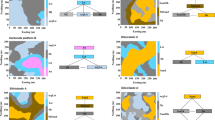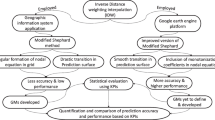Abstract
Testing the accuracy of 3D modelling algorithms used for geological applications is extremely difficult as model results cannot be easily validated. This paper presents a new approach to evaluate the effectiveness of common interpolation algorithms used in 3D subsurface modelling, utilizing four synthetic grids to represent subsurface environments of varying geological complexity. The four grids are modelled with Inverse Distance Weighting and Ordinary Kriging, using data extracted from the synthetic grids in different spatial distribution patterns (regular, random, clustered and sparse), and with different numbers of data points (100, 256, 676 and 1,600). Utilizing synthetic grids for this evaluation allows quantitative statistical assessment of the accuracy of both interpolation algorithms in a variety of sampling conditions. Data distribution proved to be an important factor; as in many geological situations, relatively small numbers of randomly distributed data points can generate more accurate 3D models than larger amounts of clustered data. This study provides insight for optimizing the quantity and distribution of data required to accurately and cost-effectively interpolate subsurface units of varying complexity.







Similar content being viewed by others
References
Bond CE, Gibbs AD, Shipton ZK, Jones S (2007) What do you think this is? “Conceptual uncertainty” in geoscience interpretation. GSA Today 17(11):4–10. doi:10.1002/(SICI)1099-095X(199601)7:1<1:AID-ENV157>3.0.CO;2-Y
Brus DJ, De Gruijter JJ, Marsman BA, Visschers R, Bregt KA, Breeuwsma A, Bouma J (1996) The performance of spatial interpolation methods and choropleth maps to estimate properties at points: a soil survey case study. Environmetrics 7(1):1–16. doi:10.1002/(SICI)1099-095X(199601)7:1<1:AID-ENV157>3.0.CO;2-Y
Burrough PA (2001) GIS and geostatistics: essential partners for spatial analysis. Environ Ecol Stat 8(4):361–377. doi:10.1023/A:1012734519752
Burt A (2007) Three-dimensional geological modelling of thick quaternary deposits in the Barrie-Oro area, central Ontario: new modelling techniques. In: Summary of field work and other activities 2007. Ontario geological survey open file report 6145:35-1–35-5
Davis JC (2002) Statistics and data analysis and geology. Wiley, New York
de Kemp EA (2006) 3-D interpretive mapping: an extension of GIS technologies for the geoscientist. In: Harris JR (ed) GAC special paper 44: GIS for the earth sciences. GAC, Canada
Dille JA, Milner M, Groeteke JJ, Moretensen DA, Williams MM (2003) How good is your weed map? A comparison of spatial interpolators. Weed Sci 51(1):44–55. doi:10.1614/0043-1745(2002)051[0044:HGIYWM]2.0.CO;2
Heuvelink GBM (1998) Error propagation in environmental modelling with GIS. Taylor and Francis, London
Isaaks EH, Srivastava RM (1989) An introduction to applied geostatistics. Oxford University Press, New York
Jackson I (2007) So where do we go from here? Three-dimensional geologic mapping for groundwater applications. Minnesota geological survey open file report 07-4:19–22
Jones NL, Davis RJ, Sabbah W (2003) A comparison of three-dimensional interpolation techniques for plume characterization. Groundwater 41(4):411–419. doi:10.1111/j.1745-6584.2003.tb02375.x
Kaufmann O, Martin T (2008) 3D geological modeling from boreholes, cross-sections and geological maps, application over former natural gas storage in coal mines. Comput Geosci 34(3):278–290. doi:10.1016/j.cageo.2007.09.005
Keefer DA (2007) A framework and methods for characterizing uncertainty in geologic maps. In: Thorleifson LH, Berg RC, Russell HAJ (eds) Three-dimensional geologic mapping for groundwater applications. Minnesota Geological Survey, Open-File Report 07-4. pp 23–26
Kessler H, Lelliott M, Bridge D, Ford F, Sibusch HG, Mathers S, Simon Price S, Merritt J, Royse K (2005) 3D geosciences models and their delivery to customers. Three-dimensional geologic mapping for groundwater applications. Geological survey of Canada, open file 5048:39-42
Krajewski SA, Gibbs BL (1996) Understanding contouring. Gibbs Associates, Colorado
Kravchenko AN (2003) Influence of spatial structure on accuracy of interpolation methods. Soil Sci Soc Am J 67(5):1564–1571. doi:10.2136/sssaj2003.1564
Lapen DR, Hayhoe HN (2003) Spatial analysis of seasonal and annual temperature and precipitation normals in southern Ontario, Canada. J Gt Lakes Res 29(4):529–544. doi:10.1016/S0380-1330(03)70457-2
Logan C, Russel HAJ, Sharpe DR, Kenny FM (2006) The role of GIS and expert knowledge in 3-D modelling, Oak Ridges Moraine, southern Ontario. In Harris JR (ed) GAC special paper 44: GIS for the earth sciences, geological association of Canada, St. John’s, pp 519–542
MacCormack KE, MacLachlan JC, Eyles CH (2005) Viewing the subsurface in three dimensions: initial results of modeling the quaternary sedimentary infill of the Dundas valley, Hamilton, Ontario. Geosphere 1:23–31. doi:10.1130/GES00007.1
Moffat AM, Papale D, Reichstein M, Hollinger DY, Richardson AD, Barr AG, Beckstein C, Braswell BH, Churkina G, Desai AR, Falge E, Gove JH, Heimann M, Hui D, Jarvis AJ, Kattge J, Noormets A, Stauch VJ (2007) Comprehensive comparison of gap-filling techniques for eddy covariance net carbon fluxes. Agric For Meteorol 147(3–4):209–232. doi:10.1016/j.agroformet.2007.08.011
Mueller TG, Pusuluri PB, Mathias KK, Cornelius PL, Barnhisel RI, Shearer SA (2004) Map quality for ordinary kriging and inverse distance weighted interpolation. Soil Sci Soc Am J 68(6):2042–2047. doi:10.2136/sssaj2004.2042
Nalder IA, Wein RW (1998) Spatial interpolation of climatic normals: test of a new method in the Canadian boreal forest. Agric For Meteorol 92(4):211–225. doi:10.1016/S0168-1923(98)OD102-6
Paulen RC, McClenaghan MB, Harris JR (2006) Bedrock topography and drift thickness models from the Timmins area, northeastern Ontario: an application of GIS to the timmins overburden drillhole database. In: Harris JR (ed) GAC special paper 44: GIS for the earth sciences, geological association of Canada, St. John’s, pp 413–434
RockWare (2006) Version 2006. RockWare, Denver
Ross M, Parent M, Lefebvre R (2005) 3D geologic framework models for regional hydrogeology and land-use management: a case study from a quaternary basin of southwestern Quebec, Canada. Hydrogeol J 13(5–6):690–707. doi:10.2136/sssaj2001.652470x
Schloeder CA, Zimmerman NE, Jacobs MJ (2001) Comparison of methods for interpolating soil properties using limited data. Soil Sci Soc Am J 65(2):470–479. doi:10.2136/sssaj2001.652470x
Tabios GQ, Salas JD (1985) A comparative-analysis of techniques for spatial interpolation of precipitation. Water Resour Bull 21(3):365–380. doi:10.1111/j.1752-1688.1985.tb00147.x
Walker DD, Loftis JC (1997) Alternative spatial estimators for ground-water and soil measurements. Groundwater 35(4):593–601. doi:10.1111/j.1745-6584.1997.tb00124.x
Weber D, Englund EJ (1992) Evaluation and comparison of spatial interpolators. Math Geol 24(4):381–391. doi:10.1007/BF00891270
Weber D, Englund EJ (1994) Evaluation and comparison of spatial interpolators II. Math Geol 26(5):589–603. doi:10.1007/BF02089243
Webster R, Oliver MA (1992) Sample adequately to estimate variograms of soil properties. J Soil Sci 43(1):177–192. doi:10.1111/j.1365-2389.1992.tb00128.x
Wu Q, Xu H, Zou X (2005) An effective method for 3D geological modeling with multi-source data integration. Comput Geol 31(1):35–43. doi:10.1016/j.cageo.2004.09.005
Zimmerman D, Pavlik C, Ruggles A, Armstrong MP (1999) An experimental comparison of ordinary and universal kriging and inverse distance weighting. Math Geol 31(4):375–390. doi:10.1023/A:1007586507433
Zwiers WG, Rainsford DRB, Bajc AF (2008) Project unit 06-026: investigation of the dundas buried Bedrock valley. Summary of field work and other activities 2008, Ontario geological survey open file report 6226:33-1–33-7
Acknowledgments
We would like to thank Dr. Jeff Harris, Dr. Antonio Paez, and the anonymous reviewers for their helpful comments and suggestions pertaining to this research, and Prateek Gupta for his assistance with manuscript preparation.
Author information
Authors and Affiliations
Corresponding author
Rights and permissions
About this article
Cite this article
MacCormack, K.E., Brodeur, J.J. & Eyles, C.H. Evaluating the impact of data quantity, distribution and algorithm selection on the accuracy of 3D subsurface models using synthetic grid models of varying complexity. J Geogr Syst 15, 71–88 (2013). https://doi.org/10.1007/s10109-011-0160-x
Received:
Accepted:
Published:
Issue Date:
DOI: https://doi.org/10.1007/s10109-011-0160-x




